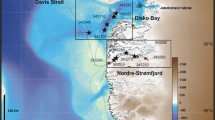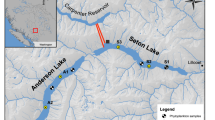Abstract
Similarities and differences between the fauna of inland saline waters in Australia and on the Altiplano are explored and explanations sought.
Elements common to both continents include the calanoid copepod genus Boeckella (B. triarticulata in Australia, B. poopoensis and B. meteoris in South America) and the cladoceran genus Daphniopsis. Salinity data for Altiplano lakes are given for six species of Boeckella and for Daphniopsis.
Ostracods have adapted to the open water of saline lakes in Australia but not in South America, a difference that may reflect past differences in the degree of predation by birds. In South America, diatoms are grazed by the flamingos Phoenicoparrus andinus and P. jamesi, while in Australia the main diatom grazer is probably the aquatic oniscoid isopod Haloniscus searlei. However, at least four species of flamingos were present in Australia during the late Cenozoic and one or more of these may well have grazed diatoms. The extinction of diatom-grazing or carnivorous flamingos, or both, in Australia may have been factors in the unique colonization of inland saline waters by H. searlei.
Similar content being viewed by others
References
Ballivian, O. & F. Risacher, 1981. Los salares del Altiplano boliviano. Metodos de estudio y estimacion economica. ORSTOM, Paris: 246 pp.
Bayly, I. A. E., 1969. The occurrence of calanoid copepods in athalassic saline waters in relation to salinity and anionic proportions. Verh. int. Ver. Limnol. 17: 449–455.
Bayly, I. A. E., 1979. Further contributions to a knowledge of the centropagid general Boeckella, Hemiboeckella, and Calamoecia (athalassic calanoid copepods). Aust. J. mar. Freshwat. Res. 30: 103–127.
Bayly, I. A. E., 1992a. The non-marine Centropagidae (Copepoda:Calanoida) of the world. In: H. J. Dumont (ed.) Guides to the Identification of the Microinvertebrates of the Continental Waters of the World. SPB Academic Publishers, The Hague.
Bayly, I. A. E., 1992b. Fusion of the genera Boeckella and Pseudoboeckella (Copepoda) and revision of their species from South America and sub-Antarctic islands. Rev. Chilena Hist. Nat. 65: 17–63.
Bayly, I. A. E. & D. W. Morton, 1978. Aspects of the zoogeography of Australian microcrustaceans. Verh. int. Ver. Limnol. 20: 2537–2540.
Bayly, I. A. E. & W. D. Williams, 1973. Inland Waters and Their Ecology. Longman, Melbourne.
Blinn, D. W., S. L. Blinn & I. A. E. Bayly, 1989. Feeding ecology of Haloniscus searlei Chilton, an oniscoid isopod living in athalassic saline waters. Aust. J. mar. Freshwat. Res. 40: 295–301.
BMR Palaeogeographic Group, 1990. Australia: Evolution of a Continent. Bureau of Mineral Resources, Australia, 96 pp.
Bowler, J. M., 1982. Aridity in the late Tertiary and Quaternary of Australia. In W. R. Barker & P. J. M. Greenslade (eds), Evolution of the Flora and Fauna of Arid Australia. Peacock Publication, Adelaide: 35–45.
Crawford, A. R., 1974. A greater Gondwanaland. Science 184: 1179–1181.
De Deckker, P., 1983. Notes on the ecology and distribution of non-marine ostracods in Australia. Hydrobiologia 106: 223–234.
De Deckker, P., 1986. What happened to the Australian aquatic biota 18 000 years ago? In De Deckker, P. & W. D. Williams (eds), Limnology in Australia. CSIRO, Melbourne: 487–496.
De Deckker, P. & M. C. Geddes, 1980. Seasonal fauna of ephemeral saline lakes near the Coorong Lagoon, South Australia. Aust. J. mar. Freshwat. Res. 31: 677–699.
Dodson, S. J. & D. L. Egger, 1980. Selective feeding of Red Phalaropes on zooplankton of Arctic ponds. Ecology 61: 755–763.
Hann, B. J., 1986. Revision of the genus Daphniopsis Sars, 1903 (Cladocera: Daphniidae) and a description of Daphniopsis chilensis, new species from South America. J. Crustacean Biol. 6: 246–263.
Hurlbert, S. H., 1982. Limnological studies of flamingo diets and distributions. Nat. Geogr. Soc. Res. Rep. 14: 351–356.
Hurlbert, S. H. & C. Y. Chang, 1983. Ornitholimnology: effects of grazing by the Andean flamingo (Phoenicoparrus andinus). Proc. Natl. acad. Sci. USA 80: 4766–4769.
Hurlbert, S. H. & J. O. Keith, 1979. Distribution and spatial patterning of flamingos in the Andean altiplano. Auk 96: 328–342.
Hurlbert, S. H., M. Lopez & J. O. Keith, 1984. Wilson's Phalarope in the Central Andes and its interaction with the Chilean Flamingo. Rev. Chilena Hist. Nat. 57: 47–57.
Kershaw, P., 1981. Climate and Australian flora. Aust. Nat. Hist. 20: 231–234.
Ogilvie, M. & C., 1986. Flamingos. Alan Sutton, Gloucester, 121 pp.
Owen, H. G., 1983. Atlas of continental displacement, 200 million years to the present. C.U.P., Cambridge.
Rich, P. V., G. F. van Tets, T. H. V. Rich & A. R. McEvey, 1987. The Pliocene and Quaternary flamingos of Australia. Mem. Qd Mus. 25: 207–225.
Schwartz, S. S. & P. D. N. Hebert, 1985. Daphniopsis ephemeralis sp. n. (Cladocera: Daphniidae): a new genus for North America. Can. J. Zool. 63: 2689–2693.
Tyler, M. J., 1979. Herpetofaunal relationships of South America with Australia. In W. E. Duellman (ed.), The South American Herpetofauna: its Origin, Evolution, and Dispersal. University of Kansas, Lawrence: 73–106.
Tyler, M. J., G. F. Watson & A. A. Martin, 1981. The Amphibia: diversity and distribution. In A. Keast (ed.), Ecological Biogeography of Australia. Dr W. Junk Publishers, The Hague: 1277–1301.
Valdivia, R. & L. Burger, 1989. Descripción de Daphniopsis marcahuasensis sp. nov. (Cladocera: Daphniidae) del Perú, con la inclusión de una clave de identificación de las especies del Género. Amazoniana 10: 439–452.
Williams, W. D., 1981a. The Crustacea of Australian inland waters. In A. Keast (ed.), Ecological Biogeography of Australia. Junk, The Hague: 1103–1133.
Williams, W. D., 1981b. The limnology of saline lakes in western Victoria: A review of some recent studies. Hydrobiologia 82: 233–259.
Williams, W. D., 1983. On the ecology of Haloniscus searlei (Isopoda, Oniscoidea), an inhabitant of Australian salt lakes. Hydrobiologia 105: 137–142.
Williams, W. D. & M. W. Mellor, 1991. Ecology of Coxiella (Mollusca, Gastropoda, Prosobranchia), a snail endemic to Australian salt lakes. Palaeogeogr. Palaeoclim. Palaeoecol. 84: 339–355.
Zwick, P., 1981. Plecoptera. In A. Keast (ed.), Ecological Biogeography of Australia. Dr W. Junk Publishers, The Hague: 1171–1181.
Author information
Authors and Affiliations
Rights and permissions
About this article
Cite this article
Bayly, I.A.E. The fauna of athalassic saline waters in Australia and the Altiplano of South America: comparisons and historical perspectives. Hydrobiologia 267, 225–231 (1993). https://doi.org/10.1007/BF00018804
Issue Date:
DOI: https://doi.org/10.1007/BF00018804




